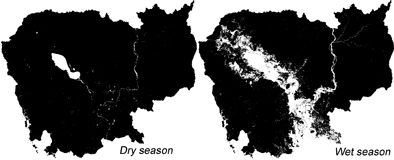Contents:
- Display of satellite images (Landsat ETM+) in the UTM coordinate, production of vegetation index (NDVI) image (GUI-based manipulation)
- Display of elevation data (SRTM) in the latitude-longitude coordinate, mosaicing, 3D display
- Prodcution of ASTER NDVI in the UTM coordinate, calculation of brightness temperature using thermal band, 3D display
- (Application) Extraction of flooding area using temporal vegetation and water indies data, instructed by Dr. Masayasu MAKI
The image finally obtained in this Lesson 4
